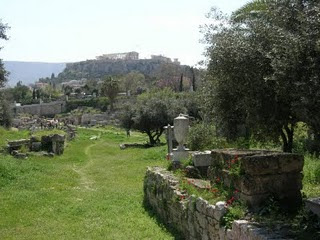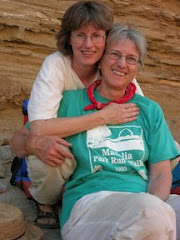 |
| Lynn Redgrave's Ecoffin fair trade wicker casket |
I first heard of Final Footprint four years ago, when newspapers reported that British actor Lynn Redgrave had chosen an Ecoffin fair trade certified wicker casket for her funeral. (See August 10, 2010
blog post.) I contacted the American Ecoffin distributor, Jane Hillhouse. Jane imports caskets and urns made of sustainable materials and has a vision of natural burial grounds all across the US, as has happened in her native England.
This April, Becky and I visited Jane Hillhouse at her home in Half Moon Bay, just south of San Francisco. Jane walked us into a large storage unit filled with merchandise and unwrapped an exquisite rattan, banana leaf, and bamboo casket. We helped her line the casket with organic cotton fabric. Back at her home, she showed us a woven wicker design and beautiful children's caskets.
 |
| Jane Hillhouse with rattan, banana leaf, bamboo casket |
 |
| Adult and children's caskets from Final Footprints |
Jane can fold down the back seats of her Prius and load
 |
Jane loading a casket into
her Prius |
an adult casket into it by herself, demonstrating that a family can easily transport their loved one to the cemetery rather than hire a mortician to perform this final act of love.
 |
Jane Hillhouse helping find affordable caskets
for landslide victims in Washington state |
As Becky and I were about to continue our drive to Napa, Jane's phone rang. It was a woman from the sheriff's department in Washington state's Snohomish county, hit several days earlier by a devastating mud slide. Many families needed to bury their dead, and some were looking for alternatives to costly funeral home caskets. Could Jane ship eco-coffins to Washington? Jane offered the families a discount on any casket in stock. (Final Footprint ships coffins all over the United States and Canada,)
Two months later we were with Jane at the Funeral Consumers Alliance national conference in Minneapolis. She had an eco-casket on display for the almost 100 North American funeral activists, including several members of the Minnesota Threshold Network.
 |
L to R: Minnesota State Rep. Carolyn Laine,
home funeral educator Jerrigrace Lyons of Final Passages,
Nancy Manahan, Jane Hillhouse, Becky Bohan |
 |
| Prairie Oaks Memorial Eco-Garden hearse at the cemetery |
On the last day of the FCA conference, Jane took her Final Footprint casket to Prairie Oaks Memorial Eco-Gardens in Inver Grove Heights, Minnesota's first natural burial grounds.
The owner Tony Weber gave FCA attendees a tour of Prairie Oaks, including a recent natural grave, with no embalming, no metal or hardwood casket, no concrete grave liner, and no imported granite headstone. Just a body lying gently in the earth in a biodegradable shroud or an eco-casket like one of Jane Hillhouse's, beneath an oak tree, providing bio-nourishment to the forest and prairie. The location can be marked with a tree or a stone that's native to the area or with GPS coordinates.
 |
| Recent green grave at Prairie Oaks |
For me, green is the way to go.
More information about green burials is at:
Final Footprints Eco-Caskets and Natural Burial:
www.finalfootprints.com
Prairie Oaks Eco Memorial Gardens,
www.mngreengraves.com, is featured in the February 2014 issue of
Natural Awakenings Magazine. It includes a graphic illustrating the main differences between a conventional burial and a green burial:
www.natwincities.com/Twin-Cities/February-2014/Prairie-Oaks-Memorial-Eco-Gardens-Offers-Green-Burials/
Minnesota Threshold Network,
www.mnthresholdnetwork.blogpress.com
Funeral Consumers Alliance of Minnesota:
www.fcaofmn.org
Nancy Manahan
Minnesota Threshold Network member





















